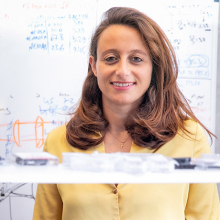Dr. Osip Schwartz
A laser focus on the microscopes of tomorrow
New scientists

Electron microscopes are indispensable in many branches of research. Using a beam of electrons to capture the image of an object, rather than a beam of light like their optical counterparts, these microscopes are able to reach atomic-scale resolutions, some 500,000 times smaller than what the human eye can see.
But while the field of electron microscopy has advanced drastically in recent years, scientists still have to contend with many stubborn constraints that hinder their ability to image many biological specimens.
Dr. Osip Schwartz, who is joining the Department of Physics of Complex Systems, is trying to solve these problems by using lasers to control the electron beams on a quantum level. He and his colleagues at the University of California, Berkeley employed a laser approach to tackle one of the most long-standing challenges in electron microscopy: developing a so-called “phase plate.” Phase plates are widely used in optical microscopy to image samples that are otherwise transparent, in a technique called phase contrast, which garnered the 1953 Nobel Prize in Physics.
Bringing this method into electron microscopy can yield enormous benefits, as many specimens, especially in life sciences, are transparent to electron beams. However, because of the way electron beams interact with matter, creating an ideal phase plate for electrons proved challenging. This prompted the team to pursue an entirely new approach, which involved controlling electron wave functions.
By bouncing a laser beam thousands of times between two mirrors, Dr. Schwartz and his colleagues created the highest sustained laser intensity ever reported, and allowed them to control electron beams.
Then they harnessed this new capability to build a laser phase plate that sidesteps the limitations of earlier phase plate models and can potentially provide nearly ideal phase contrast images. Now, he will use laser-based technology in his new lab at the Weizmann Institute to enrich the electron microscopy toolbox and develop new imaging modalities. While most other electron microscope facilities serve large groups of users and do not permit alterations to their equipment, Dr. Schwartz’s lab will house its own electron microscope. This will allow the group to make any modification they want, including inserting high-powered laser gadgets. By equipping electron microscopes with similar laser technology that he used for his novel phase plate, he hopes to improve these instruments’ signal-to-noise ratio, increase throughput speeds, discover new contrast mechanisms, and capture images that previously could not be captured.
Biosketch
Born and raised in Russia, Dr. Osip Schwartz received his BSc in physics, cum laude, in 2004 at Novosibirsk State University. He then immigrated to Israel where he earned his MSc (2008) and PhD (2012) in physics in Prof. Dan Oron’s lab in the Faculty of Physics at the Weizmann Institute. After completing a postdoctoral fellowship in 2013 at the Weizmann Institute under the supervision of Prof. Roee Ozeri, he worked as an algorithm developer at Nova Measuring Instruments in Rehovot. He then moved to California where he completed his second postdoctoral fellowship at the University of California, Berkeley in 2019. He returned to the Weizmann Institute to the Department of Physics of Complex Systems as a faculty member in 2021.
Dr. Schwartz’s postdoctoral research was supported by the Human Frontier Scientific Program Fellowship, and his PhD studies were funded by the Adams Fellowship of the Israel Academy of Sciences and Humanities. He was also awarded the Dean’s Prize of Excellence from Weizmann’s Feinberg Graduate School for his outstanding MSc work in 2009, as well as the Gad Reshef Memorial Prize in 2013.
He and his wife Marina have two children, Katya and Dima, two cats, and a tortoise.








